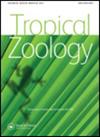Vertical distribution and daily patterns of birds in the dry deciduous forests of central western Madagascar
IF 0.4
4区 生物学
Q4 ZOOLOGY
引用次数: 6
Abstract
Data on the vertical distribution and ecological requirements of forest birds in western Madagascar are poorly documented. Strata use of forest-dwelling birds associated with vegetation structure and daily temperature patterns was examined in the dry deciduous forest of Kirindy. Six line transects of 1000 m each were used to survey birds and linear sampling to quantify vegetation structure. Data loggers were employed to record differences in temperature across vertical forest strata. A total of 3468 observations of 37 bird species were recorded. In the early morning, birds called frequently and used the canopy, at mid-day, when temperature in the upper strata increased on average around 7oC, they tended to descend along a vertical gradient to the denser vegetation of the understory, presumably to avoid heat stress. In the case of largerbodied canopy birds, they occupied the mid-story during the heat of the day. Regardless of the time of the day, the mid-story was widely used by forest birds for feeding, roosting, and preening. These results demonstrate the sensitivity and vertical movements of birds to varying environmental conditions and provide new information on the ecology of Malagasy dry forest-dwelling birds.马达加斯加中部西部干燥落叶林中鸟类的垂直分布和日常模式
关于马达加斯加西部森林鸟类的垂直分布和生态需求的数据记录不足。在Kirindy的干燥落叶林中,研究了与植被结构和每日温度模式相关的森林鸟类的地层利用。使用6条各1000m的样线来调查鸟类,并采用线性采样来量化植被结构。数据记录器被用来记录垂直森林地层的温度差异。共记录了对37种鸟类的3468次观测。在清晨,鸟类经常鸣叫并使用树冠,在中午,当上层温度平均上升约7摄氏度时,它们倾向于沿着垂直梯度下降到下层植被密度更大的地方,可能是为了避免热应力。就大型树冠鸟类而言,它们在白天的高温下占据了中间楼层。不管一天中的什么时候,中间故事都被森林鸟类广泛用于觅食、栖息和梳理毛发。这些结果证明了鸟类对不同环境条件的敏感性和垂直运动,并为马达加斯加干林鸟类的生态学提供了新的信息。
本文章由计算机程序翻译,如有差异,请以英文原文为准。
求助全文
约1分钟内获得全文
求助全文
来源期刊

Tropical Zoology
生物-动物学
CiteScore
2.50
自引率
0.00%
发文量
1
审稿时长
>12 weeks
期刊介绍:
Tropical Zoology is an international zoological journal publishing original papers in the field of systematics, biogeography, phylogeny, ecology and conservation of all terrestrial and aquatic animal Phyla from tropical and subtropical areas.
Only papers with new information, high quality and broad interest are considered. Single species description and checklists are not normally accepted. Review papers are welcome. The journal is owned by the Istituto di Ricerca sugli Ecosistemi Terrestri of the Consiglio Nazionale delle Ricerche, Florence, Italy (CNR-IRET) who performs research into the structure and functioning of aquatic and terrestrial ecosystems, focusing in particular on anthropogenic pressure and global change. The knowledge amassed forms the scientific basis for identifying the most appropriate protective and corrective interventions, and provides support for the bodies entrusted with formulating policies for environmental protection and recovery.
 求助内容:
求助内容: 应助结果提醒方式:
应助结果提醒方式:


